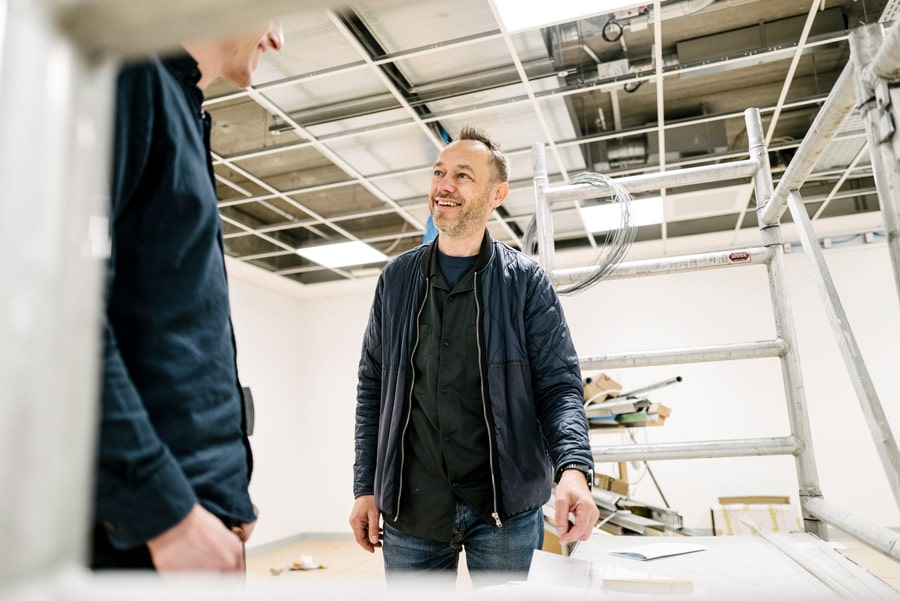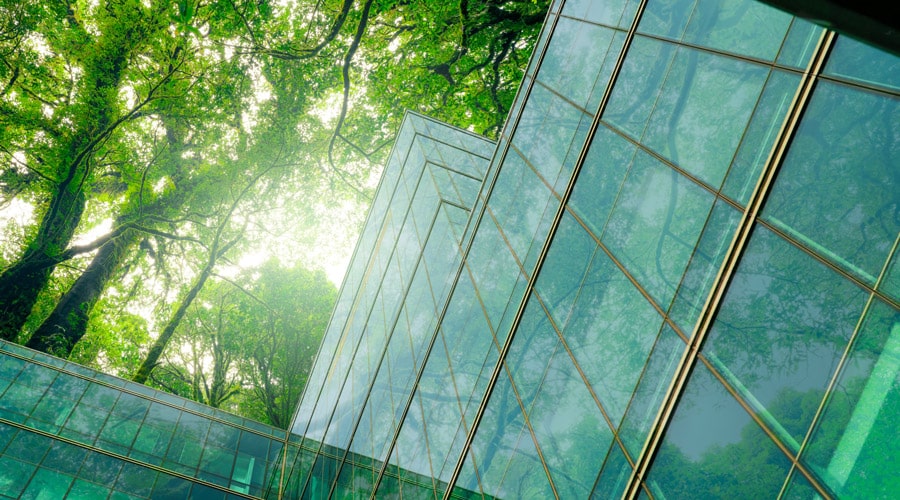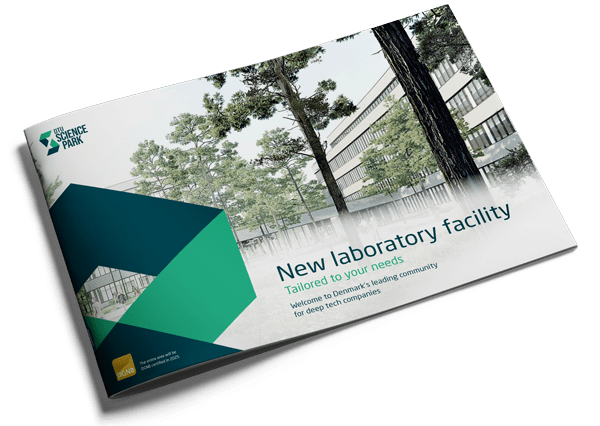Sustainability is much more than just environmentally friendly materials
Why work with the DGNB system?
Constructing new buildings is not sustainable per se. The environmental impact of buildings is a significant challenge. Collectively, buildings account for 40% of the global annual CO2 emissions. Of this, 11% comes from the embedded CO2 in building materials.
Until now, efforts to reduce buildings’ impact on the climate have primarily focused on reducing emissions from daily operations. However, new research published by the UN’s Climate Panel indicates that it is crucial to significantly reduce any form of climate impact over the coming decade to prevent temperatures from rising more than 1.5 degrees.
At DTU Science Park, we have consciously decided to back our words and visions of building responsibly with action and resources.
Jasper Wittenkamp, Project Manager at DTU Science Park, explains: “We have chosen to use DGNB as a certification system, partly in new construction and partly for the urban area in DTU Science Park in Hørsholm. We do this because we acknowledge the complexity and nuances of making sustainable choices. The DGNB system provides a qualitative framework to document our choices and as decision support.”

It’s not a challenge to work with DGNB. Instead, it’s complex and inspiring. It ensures that we make an effort and build in a balanced way for the benefit of the future.
Jasper Wittenkamp
Project Manager, DTU Science Park
DGNB is based on a holistic approach focusing on responsible resource usage, materials’ carbon footprint, energy consumption, indoor climate, water usage, biodiversity, and building flexibility. Economic viability and user well-being are also significant factors when designing new buildings, such as the upcoming laboratory building at DTU Science Park.


What is DGNB?
DGNB (Deutsche Gesellschaft für Nachhaltiges Bauen) is a voluntary certification scheme that stamps the sustainability of a building or an urban area.
A building or an urban area can be certified at three levels:
- DGNB Silver: At least 50 points and 35% in each category.
- DGNB Gold: At least 65 points and 50% in each category.
- DGNB Platinum: At least 80 points and 65% in each category.
The DGNB certification is based on three main qualities. They contain 15 criteria, each of which has a range of sub-criteria.*
The criteria have different weights and are part of a matrix of factors that affect the overall performance score:
Environmental quality
- Global warming 10%
- Hazardous substances and health hazards 10%
- Resources 10%
- Biodiversity 10%
Economic quality
- Total cost 6%
- Resilience 6%
- Mobility 6%
- Construction for operation 6%
- Responsible procurement 6%
Social quality
- Air 5%
- Noise 5%
- Light 5%
- User focus and universal design 5%
- Building quality 5%
- Landscape quality 5%
* The DGNB system is continuously evolving. An updated description was issued on January 5, 2024. These requirements are expected to come into effect from 2025. This description is based on the new requirements.
Source: Rådet for Bæredygtigt Byggeri
Who decides which DGNB criteria are most important?
According to Jasper Wittenkamp, DGNB is a valuable management tool for project managers and developers in new construction planning and design phases. It enables them to make informed, sustainable choices.
Since buildings serve different purposes, the DGNB system does not prescribe specific materials or solutions. For example, there may be specific requirements for the use of a building that necessitates choosing a particular construction material, even if it’s not the most environmentally friendly option. The developer can compensate for this by prioritizing other parameters.

It’s a matrix of all DGNB criteria. They are weighted in terms of how many points they provide for each requirement and where to focus efforts. Some may be contradictory, so it’s about creating a balance.
Jasper Wittenkamp
Project Manager, DTU Science Park

In connection with the DGNB work, DTU Science Park has had an external provider carry out a biodiversity mapping of the area in Hørsholm. The analysis assesses the quality of the green areas from A to C, where A is the highest class.

Through the biodiversity mapping, we have learned that 53% of the area in DTU Science Park is category A. We have decided to keep this intact even through new construction. When building in a Category A area, we focus on improving biodiversity and upgrading the areas not in Category A.
Lars Birch
Chief Real Estate Officer, DTU Science Park
Jasper Wittenkamp elaborates:
“Sometimes, it’s possible to create synergies between the many DGNB criteria. Surface water collection, for example, is an important criterion in DGNB, and there are several ways to address it. In connection with our upcoming construction of a new laboratory building in DTU Science Park, we can implement a LAR system (Local Rainwater Management) instead of building an underground tank beneath a parking lot. A LAR system (under category A) is a pond collecting water. In this way, we meet several ambitious DGNB criteria by collecting surface water and creating a biodiversity area connected with the building.”
Can we construct laboratories with less climate impact while ensuring optimal functionality?
Research laboratories use 3-10 times more energy per square meter than a regular office. Among other things, equipment for blood sample analysis, DNA analysis, freezers, fume hoods, ventilation, and cooling systems consumes enormous energy. Additionally, laboratory work often generates significant amounts of waste.
Reducing the climate footprint of laboratories requires changes in behavior within the laboratories and environmentally conscious building construction.
“However, it is not without challenges,” explains Jasper Wittenkamp and continues:
“Laboratory construction is generally challenged because several requirements must be met. Therefore, it is crucial to build laboratories with materials that meet the stringent stability and durability requirements necessary to ensure a reliable research environment.”
We must think long-term regarding the climate impact and well-being of the daily users while ensuring laboratories function effectively in the companies’ day-to-day operations.

It’s always better not to build new, but DTU Science Park aims to promote research. That’s why we’re building with a focus on reducing the footprint from construction.
Jasper Wittenkamp
Project Manager, DTU Science Park
DTU Science Park has initiated the construction of a new laboratory building that will be DGNB Gold certified and tailored to accommodate the individual tenants’ research needs.
With a customized infrastructure and advanced technology, the building has the potential to serve as an exemplary center for responsible construction and create the optimal environment for life science research.
The new laboratory building will be completed by early 2026. It will support DTU Science Park’s efforts in balanced construction by integrating:
- Intelligent smart building solutions to optimize security and provide a more economical and energy-efficient operation.
- IoT solutions, such as monitoring premises and user data based on usage and behavior, optimize cleaning frequency and climate control.
- Access to waste sorting and management that support recycling and reuse.
- Intelligent control systems that support and improve building operations.
- Green outdoor areas that support well-being and create a healthy work environment.
We are building tomorrow’s labs: Your space for innovation
Our state-of-the-art laboratory building will be ready in 2026. The laboratories can be equipped with high-tech instruments and customized to meet the research needs of future tenants.
Join a unique and vibrant community of like-minded life science companies. Interact, network, and gain insights from the diverse range of companies, scientists, entrepreneurs, and experts who are all part of our science park.
The unique location of the lab building in DTU Science Park in Hørsholm combines the best of two worlds: scenic surroundings in nature and immediate proximity to the city’s ecosystem and networks, providing the ideal conditions for innovation.

